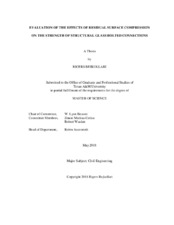| dc.description.abstract | In the recent years, glass has become the material of choice for glazing of building facades. Spider fittings are a popular method for the connection and support of glass plates that are part of the building façade. This application requires the design of glass plates with mounting holes. To increase the strength of glass plates used in glazing applications, residual surface compressive stresses are often induced into the plates through heat-treatment. In designing these connections, engineers have often assumed that the ultimate strength of a glass plate equals the strength of the pre-heat-treated plate combined with the amount of residual surface compression induced during heat-treatment. The focus of this thesis is to understand if this concept is conservative for the design of structural glass bolted connections.
This thesis studied the combined effects of the residual surface compression, localized stress concentration, and mounting hole-edge surface flaw condition on the strength of structural glass bolted connections. The focus was to develop an understanding of how the residual surface compression affects the strength of glass around a mounting hole, for a given geometry and edge condition. This was done by experimentally evaluating the strength of glass plate specimens with varying levels of residual surface compression. All specimens had identical geometry and a centered mounting hole with a constant diameter. Experimentally recorded ultimate loads were converted to ultimate stresses using finite element analysis (FEA). Values of ultimate stress were then adjusted to generate equivalent 3-second load duration failure stresses.
It is concluded that for the glass specimens tested herein, estimating the ultimate strength of heat-treated glass as the strength of pre-heat-treated glass combined with the amount of residual surface compression induced during heat-treatment yields to a conservative design. The possible effects of residual surface compression, combined with stress concentrations around the mounting hole, and the hole-edge surface conditions are also shown. Lastly, this thesis gives recommendations for further research on this topic. | en |


